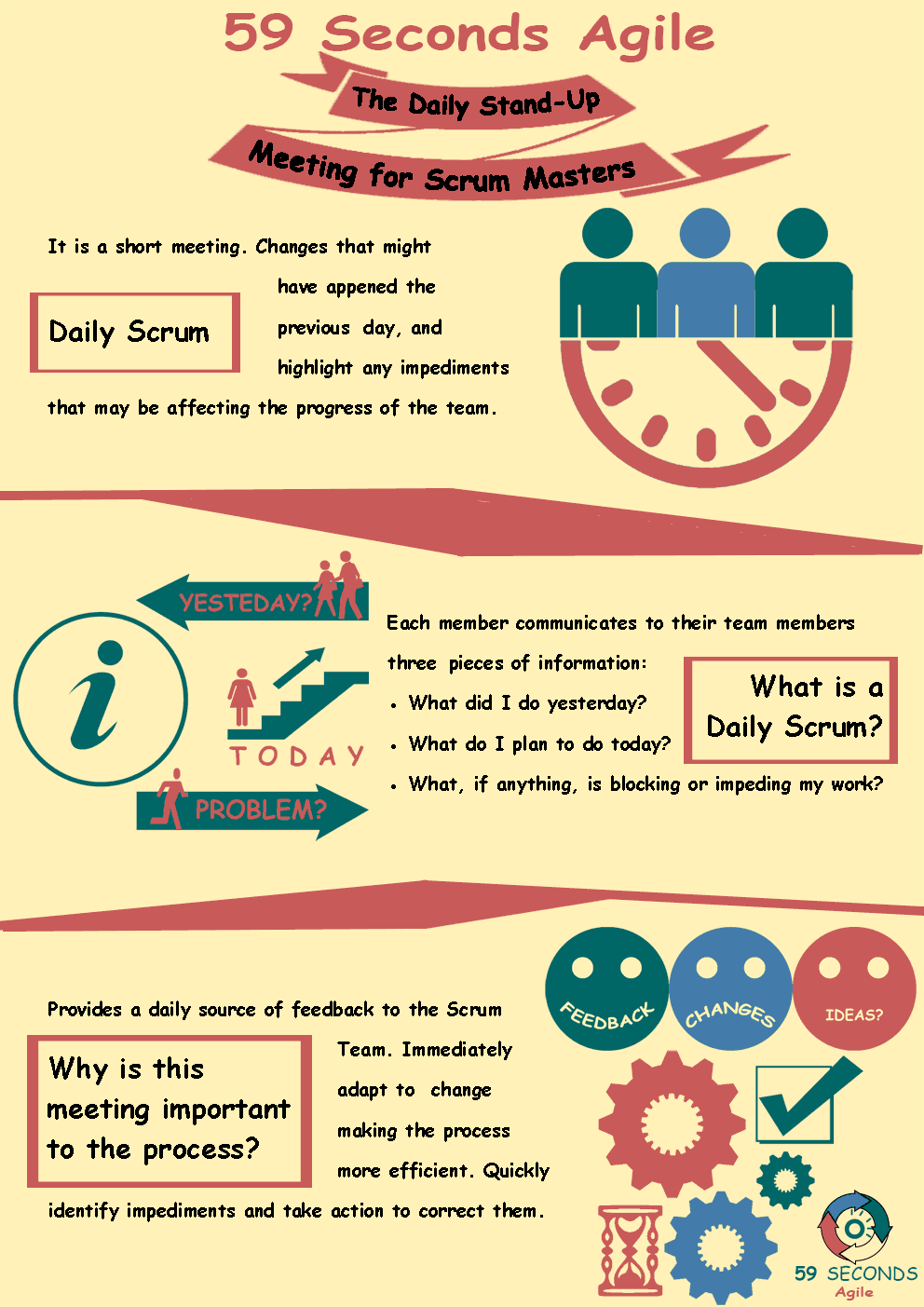What is the Daily Scrum, when does it take place and who is involved? The Daily Scrum is one of the most important ceremonies in a Scrum Project.
The Agile Daily Scrum Meeting
A 59 Seconds Agile Video Animation
The Daily Scrum for Developers
A 59 Seconds Agile Article
The daily scrum meeting is one of the most iconic parts of Agile software development. Of all the changes from traditional development, the stand-up meeting is one of the most obvious. Few people will deny the benefits of the stand-up meeting. It is absolutely worth the time investment for the effects that it yields. The stand-up meeting keeps the entire scrum team informed, and makes certain that problems are handled quickly. Of all the roles on the Scrum team, this helps software developers in particular.
The recurring theme of stand-up meetings is communication. Every part of the stand-up, from the input and output, to the tools and who participates in the meeting, are geared toward open communication. Agile software development attempts to reduce unnecessary documentation, but it is important for all parties involved to know what is going on. Of all roles and jobs, developers need constant communication. Without current information, developers can waste effort by working on the same task, or let issues slow progress over time.
Inputs to the Daily Scrum
Every stand-up meeting typically has an input of 3 questions answered by every team member. The development team must explain what they worked on the previous day, what they plan to work on today, and if they have any issues that are either currently or likely to impact progress. These questions address most of the concerns that might slow progress on the software product. By answering these questions at the beginning of each day, no problem goes more than a day without an update.
These questions apply to any role on the development team, but how do they specifically apply to developers? The question of what developers worked on yesterday typically covers what task they wrote code for. Also, developers should discuss what tasks they finished, if any. If they have an idea of how much time remains on a task, developers can give an estimate to the rest of the team. Similarly, what a developer is working on today focuses on the task. If developers believe that they might finish the task before the end of the day, they might announce what task they plan to work on next.
Perhaps more important than what developers are working on, is whether they are currently experiencing issues. These issues could be a variety of different problems. If developers come to an issue that needs to be confirmed, they may be waiting for analyst confirmation. If multiple departments are working together on a task, developers from one department might be waiting for another department to finish their part of the work. Anything that is preventing full efficiency should be announced as an issue.
Outputs of the Daily Scrum
The most valuable output from the stand-up meeting is a list of issues that need to be handled. Where traditional development may let problems go for days or weeks without resolution, stand-up meetings in Agile mean they must be worked on within the day. Developers are relieved from waiting on other departments and roles to handle their work. If a developer announces an issue with waiting on an analyst confirmation, analysts must then take responsibility for the issue. If another department is delaying progress, the development team realizes where the issue is. With this regularly updated list of issues, the Scrum Master knows what needs to be handled by developers to work at peak efficiency.
Daily Scrum Tasks
In addition to the list of current issues, another key output of the stand-up meeting is the current status of each task. The entire Scrum team gets a verbal update, instead of relying on each other to look at a central list. Developers know without a doubt what each other developer is working on, or has finished. When one developer finishes a task, they already know what other developers are working on, and which task they can pick up next. Instead of multiple developers picking up the same task and wasting development effort, they each grab a unique task and make progress toward finishing the product.
Prev <— Continue Reading —> Next
Learn More: Agile Daily Stand-Up
User Stories Applied
A 59 Seconds Agile Book Review
User Stories Applied by Mike Cohn is one of our favourite books on Agile User Stories. The book starts with an overview into user stories, and details what a user story is and the different aspects of them. He then discusses how to go about writing a user story, and provides details of the INVEST criteria that can be used to determine if the story is meeting all of its objectives. Next Mike gives an in depth discussion of who user stories are written for and where to begin when gathering the details for them. The book then discusses acceptance testing user stories, including how to go about specifying these criteria and the responsibilities of the development team and customers during this process.
Prev <— Continue Reading —> Next
Learn More: Agile Daily Stand-Up
The Daily Stand-Up Meeting
A 59 Seconds Agile Infographic

Prev <— Continue Reading —> Next
Learn More: Agile Daily Stand-Up
Our Favourite Agile Books
We found these books great for finding out more information on Agile Scrum:

